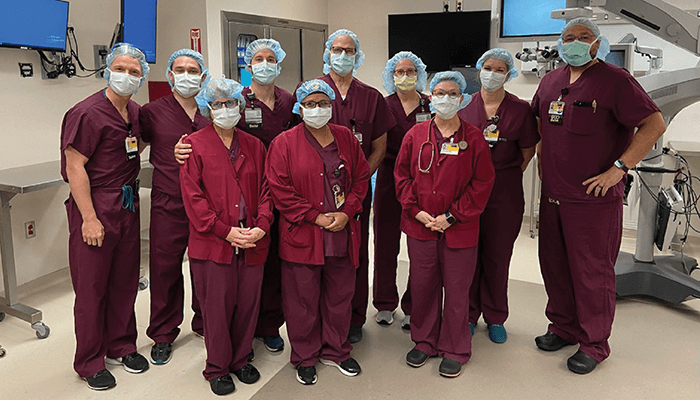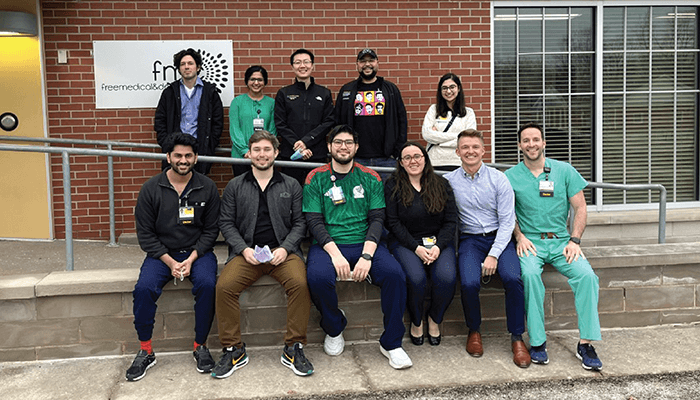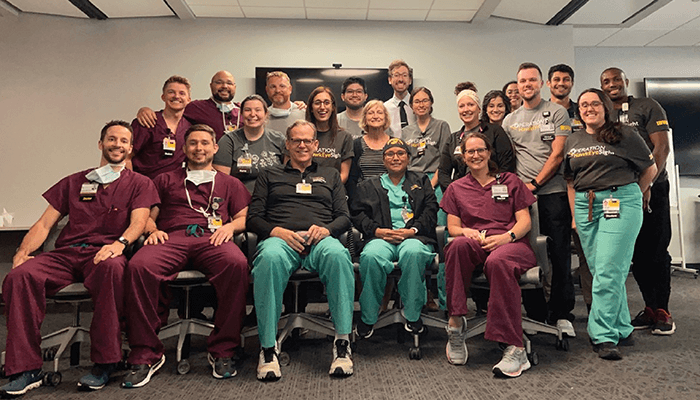
On a chilly fall morning in Iowa City, a slightly hunched elderly woman enters the Free Medical and Dental Clinic (FMC). For nearly 30 years, once a month on a Saturday, the FMC eye clinic has been staffed by volunteer medical students, residents, and faculty from the University of Iowa – and this morning we are fortunate to be part of the crew.
The woman shuffles with uncertain steps towards the exam chair; her face is etched with lines from a well lived life. Her daily purpose, she tells us, is cooking pupusas – a traditional Salvadoran dish of thick corn tortillas stuffed with various fillings – for family and friends. Indeed, it seems as though this woman sits at the center of a colorful community that revolves around food and relationships. In recent years, however, cooking has become more struggle than joy due to her fading vision; losing her eyesight has made her lose her purpose.
In the beam of our slit lamp light, two mature cataracts glow as white as cooking flour, revealing the cause of her serious vision impairment. These cataracts are, of course, treatable, but she has no access to such surgery. Unfortunately, she is not alone. Despite advances in technology, the burden of preventable blindness in the US remains substantial (1), with cataracts and diabetic retinopathy (DR) disproportionately affecting at-risk groups (2) (3) – and resulting in significant economic burden through both direct costs and productivity losses (4).
At the Iowa City FMC, these statistics manifest themselves in real-life scenarios. Like our visitor today, nearly all patients in the eye clinic are from minority groups (85 percent are Hispanic or Black), and most have underlying medical conditions (about 75 percent are diabetic). And 100 percent are uninsured.
Widening the scope
For years, the FMC outreach program has served as a primary eye care clinic for the area, screening for diseases, such as glaucoma, prescribing eye drops, and providing glasses for the most vulnerable of the community. These services undoubtedly had a positive impact, but they are unavoidably limited in scope. Some patients need more definitive care, such as cataract surgery, and our team wanted to make that happen. Beyond ophthalmology, our university is known for tough sports like football and wrestling, and so we channeled that sporting mentality to meet our challenges head-on with hawk-eyed focus. To address health disparities within our community, we didn’t just want a call to action, we wanted to take action.
To characterize our patient population at the FMC, we first performed a needs assessment survey. This not only helped us understand the vulnerability of our population, but also confirmed that the two leading causes of vision loss were treatable: cataracts and DR. We knew we could make an impact.
These insights guided our second step: securing proper equipment. We had no laser equipment at the free clinic – however, with the recent FDA approval of portable laser indirect ophthalmoscopes (LIOs), we obtained agreement from our department leadership to borrow the portable laser for our Saturday clinics.
The third step involved recruiting the right team. One major hurdle was a legal one – FMC procedures were not covered by our institution’s malpractice insurance. We worked with the university’s legal team to revise our malpractice coverage to ensure that FMC procedures could be covered. And that enabled the participation of experienced staff, opening the door to laser procedure-based clinics at FMC.
At that point, we encountered the next major barrier: money. To that end, we consulted Stephen Russell, Retina Service Director, to discuss our goals, including the initiation of a laser clinic to treat DR at FMC. The morning after our meeting, he forwarded an email that accelerated everything. “Here is your invitation.” Below those four words was an email from the University of Iowa announcing a brand new grant initiative for projects addressing health disparities in our community. The grant was for up to $100,000 and seemed to be made for projects exactly like ours.
Like a determined wrestler, we sensed the moment and pounced! Primed by our strategic preparation, we put together an application so organized and carefully planned that anyone reading it would have difficulty saying no. We formalized the development of mechanisms to treat the two biggest causes of preventable blindness at the FMC. In February 2022, we were awarded the full pilot grant amount of $100,000 to execute our plans.
Once we had this seed funding, our program developed at speed. We used some initial funds to secure much needed equipment, negotiating with industry partners to obtain a combination optical coherence tomography and color fundus camera at a discounted price. This imaging instrument enabled us to track disease changes accurately over time, greatly facilitating our ability to provide quality continuity of care, especially for our patients with DR.
Within two months of securing grant funding, we held our first laser day at the FMC to treat DR. We specifically identified patients with “high risk” proliferative DR, for which laser treatment has been shown to reduce the risk of severe vision loss by up to 50 percent (5). The initial laser clinic was a great success, and we have since held laser clinics every other month to continue treating the patients at highest risk. During the initial one-year grant period, we coordinated 11 FMC ophthalmology clinics, providing care to 142 uninsured patients who otherwise had no access.

Time for Hawkeye
Our next strategic move was to develop a formal program, named Operation HawkeyeSight (OHES), to provide free cataract surgery for patients from the FMC. By establishing an infrastructure of funding, equipment, and volunteer personnel, we were able to bring together multidisciplinary leadership from all different arms of our hospital system to start tackling barriers. Despite the complexity of building such a program, our clear mission, strategic organization, and many amazing team members took down each barrier, one by one.
By the end of summer, our hard work paid off. We hosted our first ever free cataract surgery day in August 2022 – and our papusa chef was one of the first patients to benefit. She walked in on a Saturday morning, greeting volunteers whose voices she recognized from previous FMC clinic visits. By the time she left, one of her white cataracts was gone. Now, she could not only hear our voices, but also see our smiles.
Seeing the fruits of our labor led the team towards issues of sustainability. We didn’t want OHES to last a single day – we wanted it to be a recurring program, woven into the fabric of our hospital’s charitable missions. We were grateful to have had support from industry (Alcon) and the hospital, so that almost all the equipment, lenses, and medications were donated for our first OHES day, and we are now looking to solidify those partnerships for the program. Remarkably, nearly the entire cost (~83 percent) of our initial cataract surgery day was from our own hospital (for example, facility fees for use of the OR), and we are working hard with administrative leaders to minimize those costs in the future.
Our initial grant funding was essential to the launch of OHES, but these early funds were limited. Recognizing the importance of continued funding, we established a website (http://HawkeyeSight.org), built by volunteers who donated their expertise to develop a place to raise awareness of our initiatives and provide a portal for philanthropic support. The website aims to provide a referral pathway for uninsured patients well beyond our local FMC. In the future, eye care providers across Iowa will be able to fill out a referral form to get patients connected to our programs, thereby eliminating some barriers to access.
In February 2023, we received some more good news. Because of our initial success and continued promise, we were awarded an additional $100,000 grant to forge ahead with our health disparities work. We plan to use these new funds to grow our current initiatives toward greater sustainability and broader reach. The greatest aspect of sustainability, however, will be a continued passion for fighting to decrease health disparities in the community. We are fortunate to have a growing team of dedicated volunteers who have a hawk-eyed focused on this mission. The program we have started can only succeed with people who can cultivate and grow it; we are truly fortunate to be part of a program with leaders who have been with us every step of the way. Similarly, programs like ours are founded upon a desire to help the patients who trust us with their care.
One month after our first OHES day, we see a confident woman enter the clinic for a postoperative visit – a twinkle glinting from her new lens implant. She brings into the clinic room a food cooler, filled to the brim with pupusas. With a smile that refuses to dim, she describes the difference we have made to her life, and insists that the pupusas she made for us represent so much more than just a meal.

Thanks to the HawkEyeSight Team
Resident leadership
Cy Lewis, Arnulfo Garza, Joanna Silverman, Cheryl Wang, Tirth Shah.
Faculty leadership
Andrew Pouw, Ian Han, Jaclyn Haugsdal, Tom Oetting, Pavlina Kemp, Keith Carter.
Medical student leadership
Paige Noble, Wisam Najdawi, Kenten Kingsbury.
References
- S Besagar et al., “Association of Socioeconomic, Demographic, and Health Care Access Disparities With Severe Visual Impairment in the US,” JAMA Ophthalmology, 140, 1219 (2022). PMID: 36326732.
- R Klein et al., “The relation of socioeconomic factors to the incidence of proliferative diabetic retinopathy and loss of vision,” Ophthalmology, 101, 68 (1994). PMID: 8302566.
- SY Wang et al., “Incidence and Risk Factors for Developing Diabetic Retinopathy among Youths with Type 1 or Type 2 Diabetes throughout the United States,” Ophthalmology, 124, 424 (2017). PMID: 27914837.
- DB Rein et al., “The Economic Burden of Major Adult Visual Disorders in the United States,” Arch Ophthalmol, 124, 1754 ( 2006). PMID: 17159036.
- "Photocoagulation treatment of proliferative diabetic retinopathy. Clinical application of Diabetic Retinopathy Study (DRS) findings, DRS Report Number 8. The Diabetic Retinopathy Study Research Group," Ophthalmology, 88, 583 (1981). PMID: 7196564.
